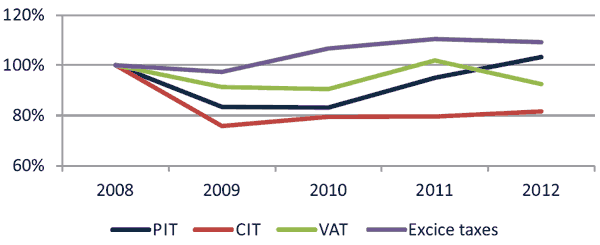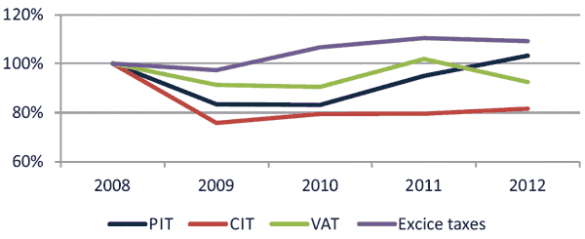Fiscal consolidation should have been the priority of the government in 2012, but due to early elections in spring, most of the measures were deferred to year 2013. As a result, public de?cit of 4.6% of GDP did not change compared to previous year. New leftist government applied some moderate changes in taxation and social contributions in 2012, but main tax package came into force in 2013. Flat tax rate was wiped out, tax hikes in corporate and personal income tax rate has been introduced. With a 6% growth of total government expenditures in 2012, the public de?cit exceeds 10% of total government tax revenues leaving the question of further tax hikes open.
1- General environment in 2012
Year 2012 should have been a turnaround year. Strong growth, decrease in unemployment, huge government revenues increase. The optimism of seemingly overcome crisis in summer 2011 lead the Slovak politicians as well as European Commission to great expectations. As many times before, the real development proved that government projections are often written with pink glasses.
Although the GDP growth in 2012 outperformed the EU average with 2.0% growth in real terms, in nominal terms it was 4.5pb lower than expected (7,2%) in the original budget proposal. Instead of expected decrease in unemployment rate, the share of people without jobs increased to 14 %. The wages decreased in real terms, nominal growth was 2.5pb lower than expected. These economic indicators had profound impact on government revenues.
But not only that. The ?scal stability of the country was hit mostly from its own local political authorities. The government, which prepared the 2012 budget, lost the con?dence of the parliament before legislating it. The breaking point was the vote on newly adjusted EFSF that was seen as the savior for the euro zone at that time. One party member of the government coalition refused to vote for the new agreement. The opposition exchanged its support of EFSF for early elections, conditioned by request that the budget will not include several austerity measures and, especially, that the labor tax reform will not be adopted. As a result the de?cit of approved budget had reached 4.6% of GDP, the same as in 2011, despite the fact, that the country has been in the Excessive De?cit Procedure. Weak ?scal performance had signi?cant impact on growth of public debt, which soared also due to membership of Slovakia in the Eurozone bailout mechanisms. Although the 52.1% of GDP debt level could be considered as extremely low by European standards, the weight of the debt measured by the number of annual tax and contribution revenues now equals the EU 27 average.
A single leftist party (SMER-SD) won the suf?cient majority in parliament elections and the single party government was appointed in April 2012. New government faced two major obligations. First, to adopt measures to meet the 2012 de?cit goal in worsening macroeconomic conditions. Second, to legislate the measures that would enable substantial de?cit cut to 2.9% of GDP in 2013, as required by the Excessive De?cit Procedure.
2- Changes in Taxation in 2012
Special bank tax was introduced in 2012. The tax base was de?ned as total liabilities discounted for own equity and individual deposits under the state guarantee scheme. The 0.4% rate has been one of the highest among the countries that implemented such tax. The revenues from this tax shall be collected to special account as a part of government ?nancial assets to provide a source for compensations in the case of ?nancial sector problems. Although it is always dif?cult (if not impossible) to regard any fractional reserves banking system as healthy, compared to many other EA countries, liquidity and solvency indicators of Slovak banking sector are exceptionally good thanks to a restructuring that took place in in 2001. For this reason, this tax shall be considered as a measure to decrease the de?cit rather than a banking sector stability measure.
Except for this tax, small changes were applied in CIT base (+ € 27 mill.) and the tobacco tax rate was increased earlier than previously planned (+ € 30 mill.). Special radio and television tax had not been cancelled as originally budgeted, thus contributing to budget revenues for some € 76 mil.
Previous government planned to adopt major tax reform and labor reform together with budget in the end of the year 2011 (especially the merging of contributions of employee and employer into only employee contribution), with neutral effect on the government revenues. In 2012 the social contribution decrease should follow. Nevertheless, none of these happened as the new government completely refused this model. Leftist SMER SD party won the elections with a promise of sustaining current system but with increased taxation of the rich. Both obligations mentioned above, 2012 de?cit and plan for 2013 should have been achieved thanks to increased taxation.
The mandatory contribution into private pension fund (tax exempted) had been signi?cantly decreased to 4% from previous 9% (the law stipulates linear increase to 6% within next 11 years); the change of 5% will be transferred to public PAYG system, improving its balance by € 145 mill. in 2012 (€ 0.5 bn. in 2013). The position of private pensions was weakened, especially with re- introduction of voluntary entry to this scheme (app. 10% roll-in expected). The primary motivation was to tackle the de?cit, nevertheless this approach corresponds with long term disagreement of the new government leaders with private savings; it has also forced majority of savers from equity funds to conser-vative bond funds. On top of it, the private pillar had been opened for several months in 2012 and 2013 so that savers could withdraw their savings and exchange them for the claim from PAYG public pensions system. As the rules for this transfers were set very generously (the savers could bring back contributions in full amount, as if they never paid any fees for fund management and never suffered any loss in the value of their investments) almost 80,000 savers returned back, bringing € 43 mill to PAYG pillar in 2012 and over € 243 mill in 2013. Nevertheless, high de?cit of PAYG system forced government to adopt some reasonable changes (although with deferred effectiveness). The retirement age will be linked to average life expectancy and the indexation of pensions will be based on pensioner’s price index. Nevertheless, even these measures are not suf?cient to eliminate the debt of the PAYG system, which should reach as much as 6% of GDP in 2060.
Otherwise, it was especially the banking sector that had to contribute to de?cit decrease. Not only the existing bank tax was almost doubled in September 2012 by broadening the base for individual deposits, the ?nancial institutions also had to pay another extraordinary fee, increasing the projected tax load by €62 mil. Banking sector should on top of income tax pay another €169 mil, what effectively doubles its tax load. Even before the bank tax, the sector contributed app. 10% of CIT. In exchange for this increase, banks do not have to contribute to deposit guarantee scheme (app. € 50 mil). The bank tax rate should be halved, when the reserve exceeds € 0.5 bn., which is expected to happen in 2015.
Another example of one off tax measure is the special fee for large companies operating at the regulated markets. The “right” to be taxed emerges when more than 50% of the company turnover is coming from regulated activities and the pro?t exceeds € 3 mil. The tax base is the pro?t exceeding this amount, and the rate is 0.363%. The special tax shall be applied during both 2012 and 2013.
The taxation policy of the government in 2012 corresponded with its left leaning orientation. It focused on banks (“undeserved” pro?ts), rich (large companies) and on the private pensions (decrease in contributions).
3- When A Growing Economy Does Not Pay More Taxes
In nominal terms, Slovak GDP is 7% higher than in 2008. Despite this growth, the tax revenues of public sector (not including contributions) are lower than in 2008. The development of four most important taxes generating 96% of revenues is illustrated in following chart.

Tax revenues growth, 2008=100%
The share of excise taxes is less than 20%, therefore lower VAT revenues (42% share) and signi?cantly decreased CIT revenues (17%) drives the total below 2008 level. Such development had a signi?cant impact on ?scal policy of the government. Especially costly and ineffective social policies, with their automatic annual indexation rules, create permanent pressure to “discover” additional revenues (e.g. fee paid at the registration of car based on the number of horse powers) and cuts in important expenditures.
There are various factors behind this development. The most important is the structure of GDP growth, which was lately driven solely by increased productivity of export oriented industrial sector, especially car manufacturing. Although three Slovak automotive companies increased the number of produced cars by more than one third (!) in 2012, this growth had only limited impact on state coffers, as export does not pay VAT. Furthermore, Slovak automotive companies operate as assembly factories, with little value added and with majority of the supplies imported from abroad. This fact, in combination with tax holidays of many foreign investors is the reason that the production growth does not translate into growth of CIT revenues. More effective assembly lines do not employ new people, hence persistently high unemployment rate with weak wage growth keeps purchasing power low, leading to stagnant domestic economy and VAT revenues (despite increased rate to 20% in 2011). General weakness of European economy keeps the pro?ts down; corporates are also decreasing their tax burden by discounting for losses recorded in 2009-2010 period. The only “powerful” tool to increase tax revenues proved to be the tobacco tax with almost 40% growth within the last 5 years. Naturally, harmonization of tax levels in this ?eld will not generate revenues growth inde?nitely, also due to the fact, that tobacco tax rate is currently the highest among the countries of Visegrád region. Notwithstanding the economic factors the effectiveness of tax collection is rather weak. According to OECD estimates based on 2006 numbers, the gap between projected and collected VAT is almost 30%, one of the highest in EU. Effective tax rate of VAT is currently estimated to be 10.4%, although it had been over 13% in period of 2004- 2007. Non-compliance, fraud but also weak and costly performance of taxation authorities, are the main reasons behind this development.
4- Changes in taxation for 2013
There were only few rather insigni?cant changes in taxation enacted in 2012, but full package of tax hikes had been adopted last year and came into force in January 2013. The legend of Slovak ?at tax rate had been de?nitely wiped out.
The second tax rate had been introduced to personal income tax. Taxable annual income exceeding € 39,725 will be taxed by 25%, the amount below the threshold remains taxed at 19%. Other small changes, mostly regarding the tax base (e.g. rent income) will lead to higher tax burden as well.
The most signi?cant change is the increase in corporate tax rate to 23%. Despite weak performance of the collection of this tax, the parliament decided to bring it to the highest level among the neighboring post communist countries while such countries like Sweden, UK, Finland or Denmark plan to bring this rate below this level (although, unlike these countries, Slovakia has still no dividend tax).
Not only income tax changes will have negative effects on labor market; the later will also be impacted by measures adopted in the area of social and health contributions. Increase of the ceiling of the tax base for social contributions to uni?ed 5* average wage (from previous 1.5 and 4*average wage) will affect especially highly quali?ed well paid workforce. But introduction of contributions to special short term limited contracts (called “Agreements”) lead to elimination of one quarter of these mostly part-time jobs (150 000 in absolute terms). Also minimum contributions paid by self- employed were increased.
In total, the 2013 budget expects an increase of revenues by € 1.6 bn. based on the adopted measures – almost 10% increase of the revenues from taxes and contributions. As there were many changes adopted, the overview with its impact on budget is listed in the following table:
In total, the 2013 budget expects an increase of revenues by € 1.6 bn. based on the adopted measures – almost 10% increase of the revenues from taxes and contributions. As there were many changes adopted, the overview with its impact on budget is listed in the foll
| Changes in Taxation and growth of revenues in 2013 | Eur ths |
| Corporate income tax rate from 19% to 23% | 298 292 |
| Personal income tax rate, 25% for income over 39,725 € | 52 948 |
| Tax base changes for self employed | 19 543 |
| Increased contributions of self employed | 51 517 |
| Increase in the maximum contribution base up to 5 times the average wage | 129 977 |
| Changes in 2nd pillar (including the transfer of savings to PAYG € 243 mil.) | 701 363 |
| Contributions from ST agreements | 124 807 |
| TV and Radio Tax | 73 881 |
| Extension of bank tax | 88 997 |
| Temporary tax on enterprises operating in regulated sectors | 81 000 |
| Others | 6 048 |
| Sum of measures | 1 628 373 |
| -in % of GDP 2012 | 2.3 |
5- Fiscal Outlook
The ?rst three months of the year already proved that the government was too optimistic. The projection of the GDP growth in 2013 had been decreased already several times and the government corrected expected tax revenues by 2% (0,5% GDP).
From a ?scal point of view, achievement of the de?cit below 3% of GDP in 2013 will be a dif?cult challenge. More than two thirds of the consolidation package was based on increased revenues. Although government created a reserve to face potential revenues drop, it might turn out to be insuf?cient. Potential risk is that the biggest chunk of expenditures cuts was based on formal agreement with representatives of local governments and municipalities, but the government lacks any tools to enforce these savings. European Commission already expects the public de?cit to reach 3.3% of GDP. If it becomes true and the nominal GDP will be lower than expected, another threshold (55%) of the Debt Brake Law will be violated forcing government to cut 3% of the most of expenditures and it will not be possible to increase the consolidated expenditures in nominal terms in 2015. If the weak ?scal performance continues in forthcoming years, and the debt exceeds 57% of GDP, according to that same constitutional law the government will have to prepare balanced budget for the year following the of?cial announcement of the breach.
Although the government plans to deal with the de?cit mostly through further cost cutting in public services and bene?ts systems, further increase in taxation shall be expected. Systematic pressure from international organization (e.g. OECD) to increase property taxes meets with the program of ruling leftist party.
Radovan ?urana
INESS, Bratislava
http://www.iness.sk




